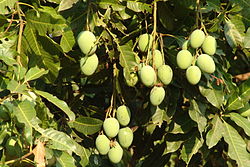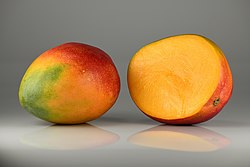Mango
Topic: Mango plant (Mangifera indica).[1]
| Mangifera indica | |
|---|---|

| |
| Unripe mango fruits | |
| Scientific classification | |
| Kingdom: | |
| Phylum: | |
| Class: | |
| Order: | |
| Family: | |
| Genus: | Mangifera |
A mango is a type of fruit.[1] The mango tree is native to South Asia, from where it has been taken to become one of the most widely cultivated fruits in the tropics. It is harvested in the month of March (summer season) until the mid of June.
India and Pakistan share the major export market of mangoes. It is also their national fruit. Ripe mangoes are very sweet in taste but they are bitterly sour before they ripen. There are many different types of mangoes found in India such as Langra, Dusshera, Chausa, Tota, and Safadi. Alphonso mangoes can be found in various parts of western India.
These mangoes are also indigenous to the southern part of Nigeria, Akwa Ibom. Described by these southerners (the Ibibios) as Grade 1 mangoes.
Benefits of Mango
- High in nutrients
- Low-calorie intake
- Mango may aid in the prevention of diabetes
- Mango contains immune-boosting nutrients
- Helps to maintain heart health
- Mango may support your eye health
- It reduces the risk of certain cancers
- Mango may improve digestion
- A versatile and easy-to-use food
Mango also has a variety of other health advantages. You may learn more about these advantages here Archived 2022-07-08 at the Wayback Machine.
Mango trees
The tree is mainly known for its fruit rather than for its wood. However, mango trees can be converted to lumber once their fruit bearing lifespan had finished. The wood is susceptible to damage from fungi and insects.[2] The wood is used for musical instruments such as Ukeleles,[2] plywood and low-cost furniture.[3] The wood is also known to produce phenolic substances that can cause dermatitis.[4] It was the state tree of Junagadh State.
Mango Media
'Carabao', a typical "Southeast Asian type" polyembryonic mango cultivar
'Langra', a typical "Indian type" monoembryonic mango cultivar
An image of Ambika under a mango tree in Cave 34 of the Ellora Caves
Sour unripe mangoes eaten with shrimp paste, salt, chili, vinegar or soy sauce in the Philippines
References
- ↑ "9 amazing Mango fruit Nutrition facts and Health benefits". Nutrition And You.com. Retrieved 2022-06-30.
- ↑ 2.0 2.1 "Mango". The Wood Database. Archived from the original on 11 January 2015. Retrieved 30 August 2014.
- ↑ "Economic importance of Mangifera indica". Green Clean Guide. Archived from the original on 7 February 2015. Retrieved 30 August 2014.
- ↑ Handbook of natural toxins. New York: Dekker. 1983. p. 425. ISBN 0824718933.










